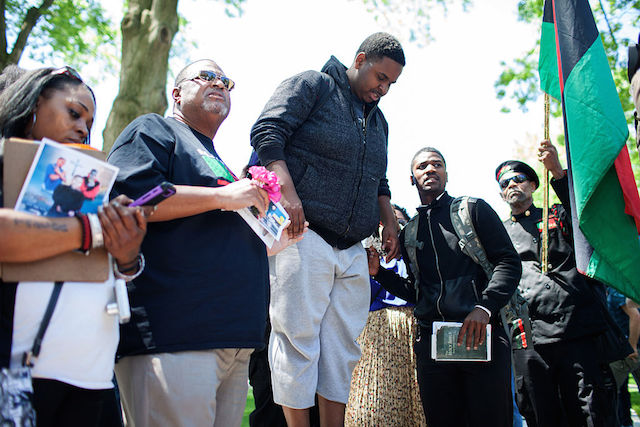Four Must-Read Stories In The Wake Of The Tamir Rice Verdict
By Mae Rice in News on Dec 29, 2015 7:12PM

CLEVELAND, OH - MAY 23: Protestors sing in front of a mock casket for Tamir Rice. (Photo by Ricky Rhodes/Getty Images)
A Cleveland grand jury decided not bring charges against the police officers who fatally shot 12-year-old Tamir Rice Monday afternoon. Tim Loehmann, the rookie cop who killed Rice, and his partner, Frank Garmback, thought the pellet gun Rice was playing with was real, in part because the 911 dispatcher did not relay to them that the caller thought the gun might be a toy.
Since the grand jury’s decision, everyone—writers most visibly—has been processing the case’s year-long arc. Here are four stories about we think are very worth reading about the decision and its implications.
Adam Serwer, “Why Grand Juries Don’t Indict Cops When They Kill,” Buzzfeed
Serwer looks at Rice’s case in the context of other recent police killings—Michael Brown’s and Eric Garner’s among them—and argues that Americans’ bias against black men, coupled with our bias towards police officers we instinctively view as “noble,” leads to a steady stream of non-indictments, even when police used banned chokeholds or acted incomprehensibly fast.
At the end of the story, he also looks at the meaning of the word “reasonable,” always central in cases where police kill civilians:
“Reasonable,” of course, is a subjective standard — even as a legal definition. Civil society decides what “reasonable” means, and when citizens make that decision, they almost always side with the police, even when the deceased is white. But when society weighs whether the deaths of black men at the hands of police are reasonable, it does so with the additional burden of American beliefs about black criminality, black superstrength, black dangerousness. On the other side are our collective beliefs about police, seen as more noble, more selfless, and more resistant to all-too-human flaws like wrath or deceit.
Michael Daly, “Tamir Rice Shooting Was a Tragedy, Not a Crime,” Daily Beast
Daly doesn’t think Loehmann and Gramback should have been indicted. In that spirit, he makes some feeble arguments, closing on a deflecting note as old as time:
Meanwhile, the ultimate fault is in ourselves for permitting our country to become a place where a 12-year-old with a toy gun gets shot to death by a cop who is found to have been in reasonable fear for his life.
However, on his way to this weak ending, he digs into the systemic failures and racism that underpin Rice’s shooting in a way that’s worth reading. The transcript of the 911 call about Rice, especially, paints a picture of a dispatcher who not only fails to home in on key details, but is also low-key into vigilante justice.
Here’s an excerpt from the end of the call, after the operator has briefly gone silent:
Caller: “Hello?”
Dispatcher: “Do you have a gun?”
Caller: “No, I do not. I’m getting ready to leave, but you know what, he’s right nearby, you know, the youth center or whatever, and he’s pulling it in and out of his pants. I don’t know if it’s real or not.”
Dispatcher: “OK, we’ll send a car there, thank you.”
What is the subtext there? “We’ll send police, if you don’t want to shoot him yourself”? Damn.
Richard A. Oppel Jr., “Six Video Frames at the Center of the Tamir Rice Case,” The New York Times
On Monday, we quoted Cuyahoga County prosecutor Timothy J. McGinty saying that, based on enhanced video footage of Rice’s shooting, “[it] is now indisputable that Tamir was drawing his gun from his waist as the police slid toward him and Officer Loehmann exited the car.”
This piece shows that central video footage, frame by frame. It doesn’t look as conclusive as McGinty says; the stills are blurry, and Rice, even in the closest close-up, looks like a floating torso; his legs blend into the concrete. There’s no consensus about what he’s doing in these frames, either—is he reaching for his pellet gun in his waistband? Putting his hands in his pockets? Seeing the opposing lawyers’ analysis of the frames, plus the frames themselves, shows how much interpretation it still takes to watch surveillance footage (or dash-cam footage, for that matter). These videos are far from purely documentary.
Christopher Ingraham, “Why white people see black boys like Tamir Rice as older, bigger and guiltier than they really are,” The Washington Post
Ingraham ties the Rice case to social science research suggesting that black children are viewed generally as older, and more diffusely guilty of crimes, than other kids. Here’s a summary of one of the many studies he cites:
In one experiment, a group of 60 police officers from a large urban police force were asked to assess the age of white, black and Latino children based on photographs. The officers were randomly assigned to be told that the children in the photographs were accused of either a misdemeanor or felony charge. The officers overestimate the age of black felony-suspected children by close to five years, but they actually underestimated the age of white felony-suspected children by nearly a year.